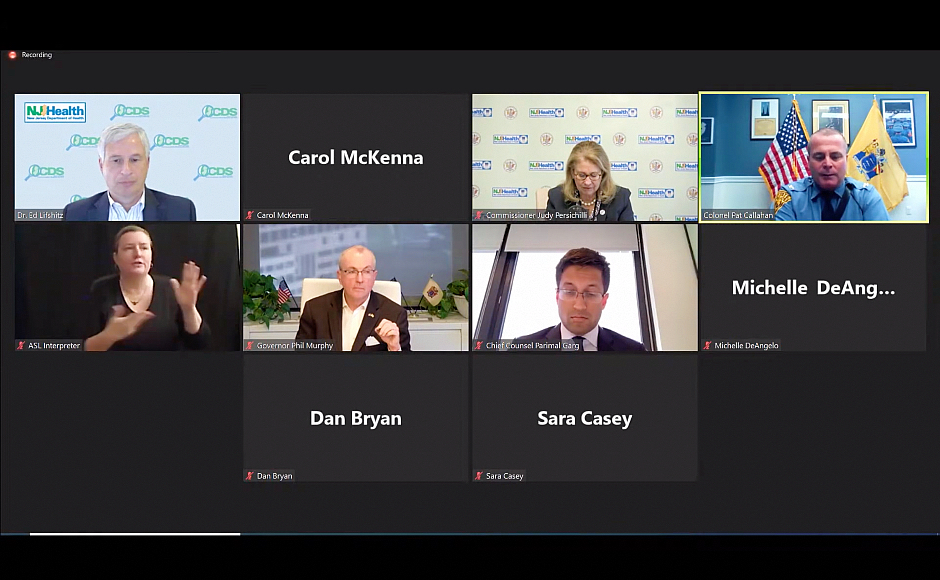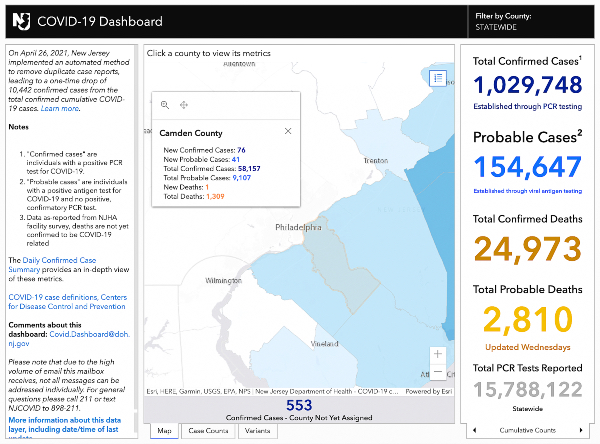The executive order could affect thousands of employees across a variety of fields as it ramps up, NJ Governor Phil Murphy says.
By Matt Skoufalos | October 20, 2021
Another 903 New Jersey residents have tested positive for novel coronavirus (COVID-19), bringing the statewide total to 1.029 million cases confirmed via polymerase chain reaction (PCR) testing, Governor Phil Murphy reported Wednesday.
New Jersey is also reporting 208 new COVID-probable cases based on antigen tests, bringing the statewide total to 154,647 positive antigen tests.
Antigen tests have a faster turnaround time than PCR tests—sometime within 15 to 30 minutes—but are less reliable at detecting active infection of the virus, and more capable of reporting false positives.
Sadly, 31 more residents have perished from complications related to the virus, bringing the statewide, confirmed death toll to 24,973 lives lost during the pandemic.
In addition to those lab-confirmed fatalities, the state has acknowledged another 2,810 probable COVID-19-related deaths.
Since March 2020, 1,058 of every 100,000 New Jersey residents have been hospitalized with COVID-19, and 284 of every 100,000 have died from COVID-19-related complications.
More than 15.788 million polymerase chain reaction (PCR) tests for COVID-19 have been performed statewide, with a 11.700-percent positivity rate per 100,000 residents.
Rate of transmission (Rt) at 0.89, spot positivity highest in South Jersey
The statewide average of COVID-19 spot positivity testing based on PCR test results stood at 5.02 percent October 16; in South Jersey, it was highest, at 6.86 percent.
Murphy attributed the higher-than-lately spot positivity to the weekend testing date, noting, “We haven’t said this in a while, but we generally see both fewer tests and disproportionately higher positivity rates on the weekends than we do in the rest of the week.”
Rt, the variable that describes the seven-day, rolling-average, statewide rate of transmission of new COVID-19 cases, hit 0.89 on October 20.
Any Rt figure less than 1.0 means that each new COVID-19 patient is infecting fewer than one other person, on average, and the spread of the virus is decreasing.
Since its mid-April-2020 COVID-19 spike, the highest reported RT in New Jersey was 1.48, recorded August 1, 2020. Prior to artificially low, adjusted reports of 0.34 in the first week of May, the lowest in the past year was 0.62, recorded June 9, 2020. On May 21, 2021, it reached a new low, of 0.59.
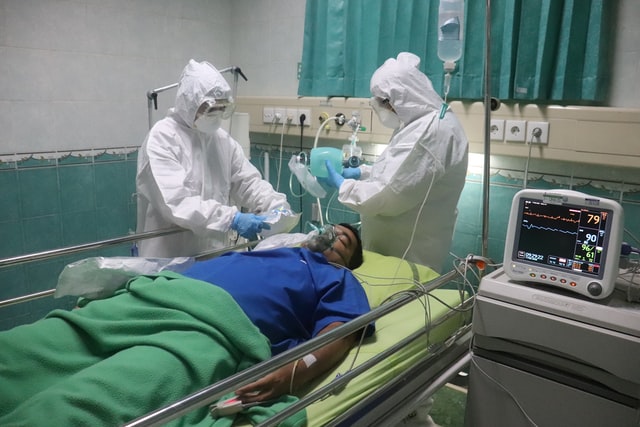
Simulated COVID-19 patient in a hospital bed. Photo by Mufid Majnun on Unsplash
COVID hospitalizations continue to hold below 900
Throughout New Jersey, 880 people currently are hospitalized with a suspected (62) or confirmed (816) case of COVID-19, Murphy said.
Among those hospitalized patients, 208 are in intensive or critical care, and 123 of the ICU and critical-care patients (53 percent) are on ventilators.
In New Jersey’s 71 critical care hospitals, 102 patients were hospitalized with COVID-19 yesterday, while 125 others were discharged.
COVID-19-based hospitalizations in New fell to fewer than 1,000 people October 6, and since then, has been holding steady around 900 people or fewer.
LTC update
Across the state, long-term care (LTC) centers have reported 1,777 cumulative outbreaks of COVID-19, and 164 are dealing with an active outbreak. LTCs account for 57,138 infected patients and staff in New Jersey, or 5.7 percent of total cases.
That includes 33,947 residents and 23,191 staffers sickened by the virus, as well as 8,601 lab-confirmed resident and staff deaths (35 percent of the statewide confirmed total), with facilities self-reporting 146 staff deaths.
Of 654 veterans residing in three state-run homes, 456 residents have tested positive for COVID-19, and 157 have died from complications related to the virus. Three hundred veterans have recovered from the virus. No resident currently is COVID-19-positive.
The facilities at Menlo Park, Paramus, and Vineland are staffed by 1,369 workers, one of whom is presently COVID-19-positive. The facilities have sustained two staff deaths related to the virus.
At state-run psychiatric hospitals, 374 of 1,139 patients and 1,136 staff members have tested positive for COVID-19. Fourteen patients and eight staffers have died from complications related to the virus.
MISC cases and schools
To date, 133 New Jersey children aged 1 to 18 have been diagnosed with pediatric multisystem inflammatory syndrome (MISC). Four of those cases were reported in Camden County, tied with Cumberland and Monmouth Counties for third-least in the state.
All those pediatric patients have tested positive for an active COVID-19 infection or the presence of COVID-19 antibodies, indicating exposure to the virus. No deaths have been associated with this syndrome in New Jersey, although several children have been hospitalized during their treatment for the illness.
From August 1, 2020 through the end of the 2020-2021 school year, 293 COVID-19 outbreaks encompassing 1,385 individual cases were traced to in-school activities in all 21 New Jersey counties. In Camden County, 18 outbreaks were linked to 78 in-school cases, sixth-most in the state.
Since the start of the 2021-2022 school year, 126 reported outbreaks—three or more students or staff who contracted the virus within the school—have been logged, affecting 658 people, a mix of students (564) and staff (94).
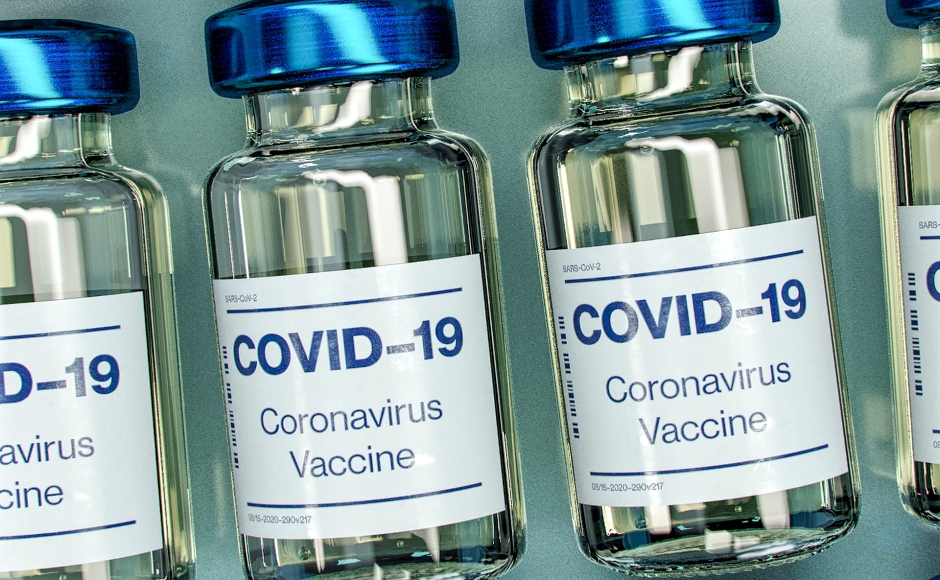
COVID-19 vaccine bottle mock-up. Photo by Daniel Schludi on Unsplash
Vaccination update: NJ approaches 6M fully vaccinated people, exceeds 12M doses administered
Across New Jersey, 12.125 million COVID-19 inoculations have been administered.
Throughout New Jersey, 5.791 million people have been fully vaccinated in-state, having received either a one-shot formulation from Johnson and Johnson or both doses of the two-shot Pfizer or Moderna vaccines.
In Camden County, 650,350 doses have been administered, seventh-most in the state; 365,309 people have been fully vaccinated.
An estimated 462,045 vaccine doses have been administered to New Jersey residents outside of the state, of which 198,898 residents are estimated to have been fully vaccinated.
The first vaccines in the state were administered December 15, 2020; by February 8—55 days later—New Jersey had immunized its millionth resident. Twenty days thereafter, that count hit 2 million, and 3 million within two more weeks.
On March 29, New Jersey crossed the 4-million-dose threshold, and the state cleared 5 million doses over the weekend of April 10, 2021. Eight days after that, New Jersey hit the 6-million-dose mark. By May 3, 2021, the state had cleared 7 million doses administered, and two weeks later, it had surpassed 8 million doses.
As of June 2, 2021, the state had cleared 9 million administered doses and 4 million fully vaccinated New Jerseyans, and on June 18, hit 4.7 million vaccinated individuals, its target goal for 70 percent of the adult population of the state.
By mid-July, that number had increased to 5.019 people fully vaccinated at New Jersey vaccination sites. At the end of August 2021, the state had exceeded 11 million doses administered and had begun approaching 6 million fully vaccinated residents.
It took until mid-October 2021 to clear the 12-millionth vaccine dose administered, at a time when some residents have begun receiving booster doses or third doses.
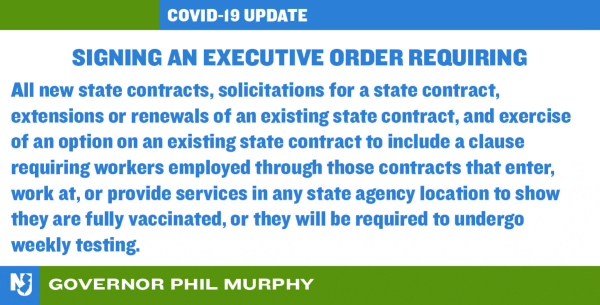
A new executive order mandates COVID-19 vaccinations or testing for NJ state contractors. Credit: NJ gov’t.
NJ to mandate contracted employees vax or test weekly
On Wednesday, Murphy announced that all new contracts, contract bids, and contract renewals with New Jersey state agencies will require “workers employed through those contracts that enter, work at, or provide services in any state agency location” to show proof of their COVID-19 vaccination or else undergo weekly testing.
“We came to the conclusion that the virus does not know whether or not you’re a full-time employee or you’re a contractor,” the governor said, citing the importance of the precautions to getting state employees back into the office in person.
“The virus does not know your employment status, and therefore we should not have some artificial distinction as a result,” he said. “We can’t undo contracts that exist, but we can mandate that going forward you’ve got to be vaccinated or subject yourself to tests.”
The executive order could affect potentially “hundreds into thousands” of contract workers over time, Murphy estimated.

